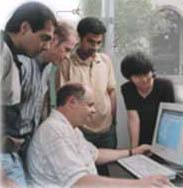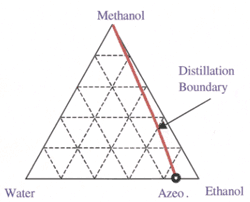| History of CAPD |
| |
| Since the 1960s, Carnegie Mellon University has spearheaded the advancement of systems concepts to all areas of science and technology. Carnegie Mellons engineering faculty have been instrumental in catalyzing revolutionary changes resulting from the introduction of computer and systems technology to science and industry. In process systems engineering (PSE), Carnegie Mellons effort began in the mid-70s with the creation of the Design Research Center. This interdisciplinary group saw significant participation by chemical engineers (Gary Powers, Art Westerberg, Ignacio Grossmann, and Larry Biegler) and led to the development of core systems methodologies, such as:
- optimization algorithms and formulations
- operations research methods,
- artificial intelligence,
- expert systems and software engineering.
|
View List of Former Graduate
Students
in CAPD |
| |

|
Moreover, with the award of Presidential Young Investigator grants to Grossmann and Biegler in the mid-80s, there was a strong challenge toattract industrial collaboration and support through matching research funds. Together with the active participation of Art Westerberg, this effort led to the creation of a cohesive research group in process systems engineering.
In 1985, we formed the Computer-Aided Process Design laboratory at Carnegie Mellon University. With support from the National Science Foundation, the Department of Energy, and the process industries, our group has pioneered the discovery, development, and application of new methods for process design, analysis, and operations. |
 |
| A summary of milestones since the founding of the CAPD consortium is given below. Currently, our research activities combine strong basic science components and industrial interactions in the areas of process synthesis and analysis, process operation, process planning, and scheduling.
Moreover, process control has become an active area of research with the addition of Erik Ydstie. The additions of Nick Sahinidis and Chrysanthos Gounaris further strengthen CAPD in the core optimization area and bring new fundamental applications at the molecular level (X-ray imaging, bioinformatics, materials design, and molecular design).
As a result of this growth, the CAPD captures a broad range of areas in Process Systems Engineering that extends far beyond traditional chemical process design. To reflect this change, the CAPD consortium was recently renamed the Center for Advanced Process Decision-making. Research efforts within the CAPD have led to the following strategies and tools for process design and operations for both batch and continuous processes:
- commercially available mathematical programming software;
- design strategies for process synthesis;
- advanced modeling environments for process simulation and analysis; and
- management of the entire design process.
|
 |
CAPD Milestones
- Started in 1985 by Larry Biegler, Ignacio Grossmann and Art Westerberg with NSF/PYI awards for Grossmann (1984) and Biegler (1985).
- Associated with Engineering Design Research Center (EDRC), an NSF sponsored Engineering Research Center founded in 1986 at CMU.
- First Industrial Short Course in 1988
- Erik Ydstie and Gary Powers join in 1991
- Textbook on Process Design in 1997
- Nick Sahinidis joins in 2007
- Chrysanthos Gounaris joins in 2013
|
 |
| |
|